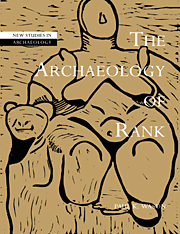Book contents
- Frontmatter
- Contents
- List of figures and tables
- Acknowledgments
- 1 The present study of past society
- 2 Social theory and social life: models of society in the archaeological study of status
- 3 Inequality and social life: a working model
- 4 Mortuary data as evidence of ranking, Part 1
- 5 Mortuary data as evidence of ranking, Part 2
- 6 The form and distribution of artifacts
- 7 Status, settlements, and structures
- 8 Çatal Hüyük: a ranked Neolithic town in Anatolia?
- Notes
- References
- Index
- NEW STUDIES IN ARCHAEOLOGY
5 - Mortuary data as evidence of ranking, Part 2
Published online by Cambridge University Press: 22 August 2009
- Frontmatter
- Contents
- List of figures and tables
- Acknowledgments
- 1 The present study of past society
- 2 Social theory and social life: models of society in the archaeological study of status
- 3 Inequality and social life: a working model
- 4 Mortuary data as evidence of ranking, Part 1
- 5 Mortuary data as evidence of ranking, Part 2
- 6 The form and distribution of artifacts
- 7 Status, settlements, and structures
- 8 Çatal Hüyük: a ranked Neolithic town in Anatolia?
- Notes
- References
- Index
- NEW STUDIES IN ARCHAEOLOGY
Summary
Undoubtedly many particulars of personal status are embodied in any set of burial remains. It is likely also that many seemingly trifling details have been manipulated to carry important meaning. It may be inevitable that much of what a burial would have communicated to culturally-aware contemporaries will be lost on the rest of us, yet it is also true that much can be learned from a study of how individual burials differ. Any attribute which can be varied – size of tomb, position of the body, number of large golden statues – can be used to mark differences in status, and so can be a source of information on a former status system. In the following sections six dimensions of mortuary variability are examined for potential cross-cultural correlation with status.
Variation in tomb form
From an ethnographic study of what mortuary variables people use to mark dimensions of the person, Binford (1971:21) found that differentiation in grave form might indicate at one time or another condition of death, age, social affiliation, and social position. Among those peoples he studied, tomb form was never used to mark either location of death or sex, and was used most often to mark status, broadly confirming the relationship of size and elaborateness (or energy expenditure) with personal status. I also found (in a small additional sample) that different grave types do not always mark either statuses or social groups.
- Type
- Chapter
- Information
- The Archaeology of Rank , pp. 87 - 102Publisher: Cambridge University PressPrint publication year: 1994



